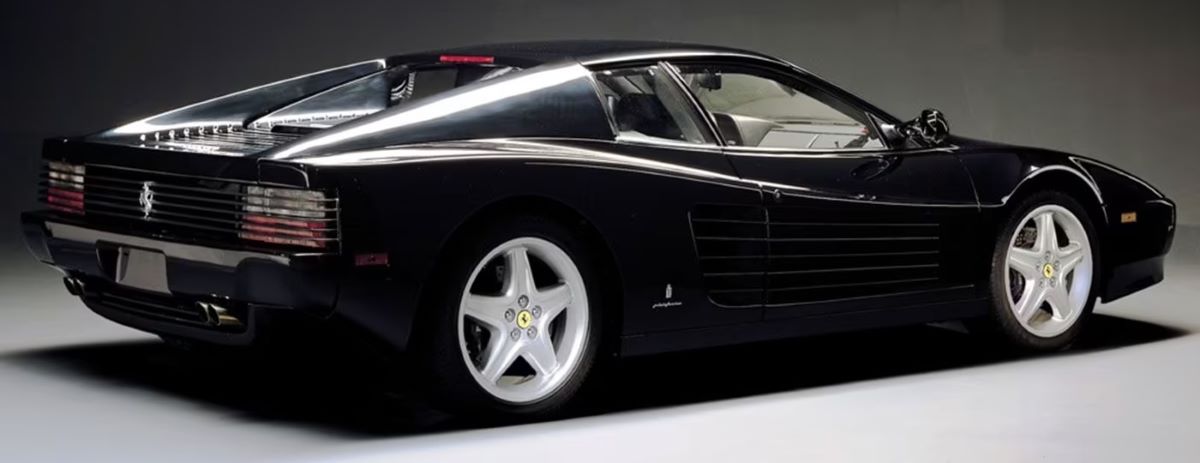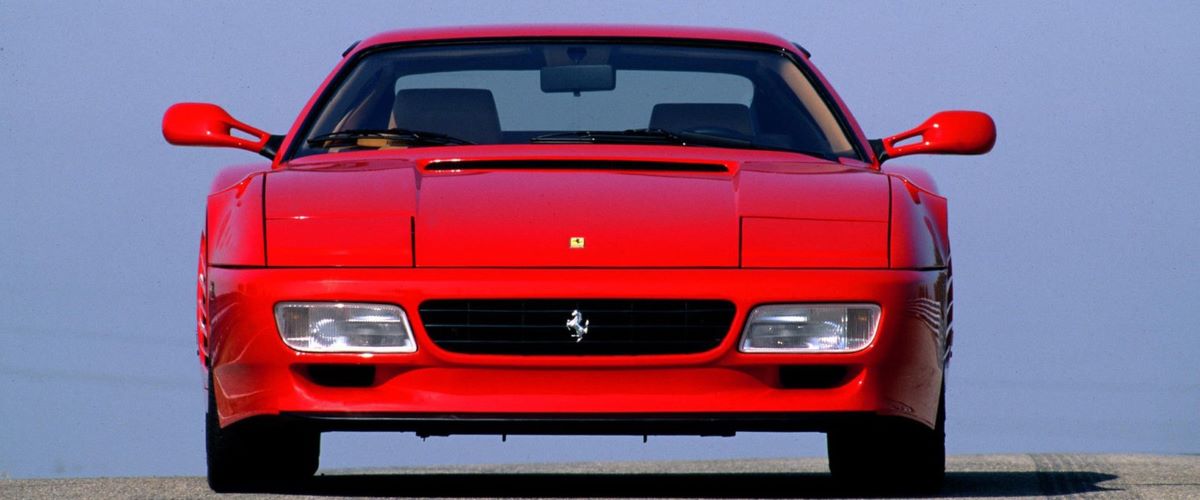
The 512 TR was the replacement for the Testarossa, and was announced for the 1992 model year. The new car witnessed a return to a model title using characters, with the figure “5” referring to the cubic capacity of the engine in litres and the “12” to the number of cylinders, whilst the “TR” was an abbreviation of Testarossa (Testa Rossa).
The main external visual differences were the nose and tail treatment, the louvre design on the engine lid and the design of the road wheels. There was also a barely noticeable different profile to the sail panel buttresses, which were plain and flowed directly into the roof panel on the 512 TR, instead of featuring the step and black perforated exhaust air grilles of the Testarossa. Internally there were changes to the seats, steering wheel design and trim details. Mechanically there were numerous changes to the engine and gearbox, which boosted power, and provided a more satisfying and positive to use gearbox. Not visually apparent was that the engine and transmission assembly location in the chassis had been dropped by 30mm, to lower the centre of gravity, and thus improve the already high standard of roadholding.
As with the Testarossa, the bodies were mounted on a 2550mm wheelbase chassis, which carried factory type reference F 110 HB, and was of virtually identical construction to that of the preceding model. All chassis numbers were in the continuous number sequence, with various world market models produced in either left or right hand drive form. The new nose treatment bore a family resemblance to that of the 348 model introduced in 1989, in the shape of the dummy grille bearing a chrome plated “Cavallino Rampante” bounded by the combined side, turn indicator, driving light units. At the rear the valance was redesigned, providing more sculpted curves, with a change of shape for the registration plate recess. The Testarossa engine lid had featured a body colour raised central panel with satin black louvres to the rear and sides. With the advent of the 512 TR, the raised section and the louvres with a new profile either side of it were painted satin black, whilst the rear portion of louvres were finished in the body colour. A 512 TR badge graced the rear lip of the engine cover, with a Ferrari script badge on its upper rear face, whilst a Testarossa script badge adorned the upper face of the satin black central section. The new alloy road wheels were a very elegant interpretation of the traditional Ferrari five spoke “star” design, featuring slim curved spokes. The front ones were 8J x 18″ diameter and the rear ones 10.5J x 18″ diameter, which increased the front track slightly, and reduced the rear track by a small amount. The wheels covered larger ventilated and cross drilled brake discs actuated by four piston callipers, with separate front and rear hydraulic circuits, and servo assistance. The independent suspension and steering system layouts were essentially similar in concept to those of the Testarossa, but with a range of changes and adjustments to suit the larger diameter road wheels, and to provide a more refined ride.
The four valves per cylinder, flat twelve, dry sump engine was an upgraded version of that used in the Testarossa, maintaining the same cubic capacity of 4943cc, with an 82mm x 78mm bore and stroke, and had factory type reference number 113 G. Changes were effected to the porting, with redesigned inlet plenums and larger valves providing more efficient fuel/air mix ingress, whilst the fuel injection and ignition system changed to a superior combined Bosch Motronic M2.7 system. New pistons were also provided that increased the compression ratio from 9.3:1 to 10:1, along with re-profiled camshafts, the net result of these changes was a jump in the claimed power output of 38bhp to 428bhp @ 6750rpm for European models and 421bhp at the same engine speed for US models. The increased power provided improved acceleration, although the top speed was still in line with that of its predecessor. The model was produced between 1991 and 1994, when the F512M model replaced it, during which time 2261 examples were produced in the chassis number range 89100 to 99743.

Specifications and Features
- 2261 Ferrari 512 TR were produced
Engine
- Typer…………………………ear, longitudinal flat-12
- Bore/stroke……………….82 x 78 mm
- Unitary displacement…411.92 cc
- Total displacement…….4943.03 cc
- Compression ratio……..10 : 1
- Maximum power……….315 kW (428hp)@6750 rpm
- Power per litre………….87 hp/l
- Maximum torque………491 Nm (50 kgm)@ 5500 rpm
- Valve actuation…………twin overhead camshafts per bank, four valves per cylinder
- Fuel feed………………….Bosch Motronic M2.7 electronic injection
- Ignition……………………Bosch Motronic M2.7 electronic, single spark plug per cylinder
- Lubrication………………dry sump
- Clutch…………………….single-plate
Chassis
- Frame………………………tubular steel
- Front suspension………independent, unequal-length wishbones, coil springs, gas-filled telescopic shock absorbers, anti-roll bar
- Rear suspension……….independent, unequal-length wishbones, coil springs, twin gas-filled telescopic shock absorbers each side, anti-roll bar
- Brakes…………………….discs
- Transmission…………..5-speed + reverse
- Steering…………………..rack-and-pinion
- Fuel tank…………………capacity 100 litres
- Front tyres……………….235/40 ZR 18
- Rear tyres………………..295/35 ZR 18
Bodywork
- Type………………………two-seater, berlinetta
- Length……………………4480 mm
- Width……………………..1976 mm
- Height…………………….1135 mm
- Wheelbase……………….2550 mm
- Front track………………1532 mm
- Rear track………………..1644 mm
- Weight……………………1473 kg (dry)
Performance
- Top speed………………..313.8 km/h
- Acceleration
0-100 km/h……………….4.8 sec
0-1000 m…………………22.9 sec



You must be logged in to post a comment.